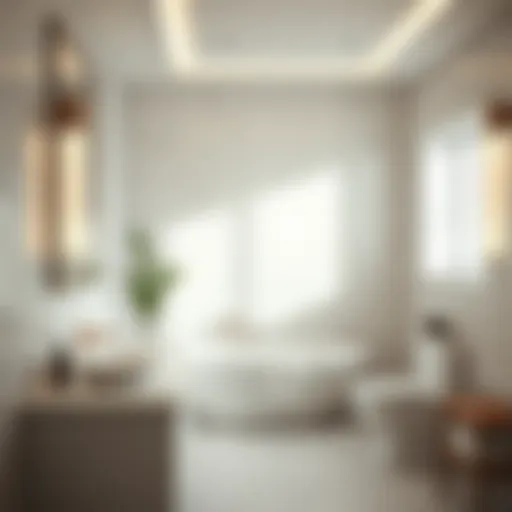Bathroom Panels: A Smart Alternative to Traditional Tiles
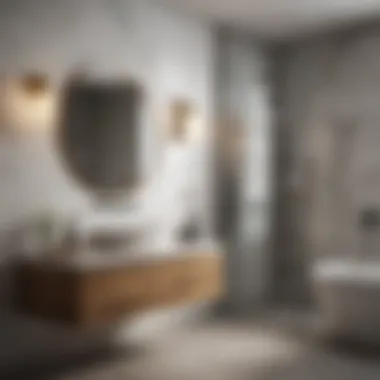

Intro
When it comes to bathroom renovations, the choice of wall coverings can make or break the entire aesthetic of the space. Traditional tiles have long held the throne in bathroom design, but there’s a new contender stepping up to the plate: bathroom panels. These versatile and visually appealing solutions are capturing the attention of homeowners, architects, and designers alike, offering a fresh approach to both style and functionality.
Bathroom panels come in various materials and designs, challenging the status quo that has reigned for years. They present an opportunity to not just give your bathroom a facelift but to also simplify the upkeep that comes with more traditional surfaces. Whether you’re in the thick of a renovation project or simply dreaming up ideas for your next home improvement, understanding the benefits and options available with bathroom panels is crucial to making informed choices.
In this article, we'll explore the trending styles of bathroom panels, dive into the compelling color palettes, and assess the practical advantages they offer. Hopefully, this will illuminate ways to enhance your bathing experience while keeping your personal style at the forefront.
Trending Styles
Modern Minimalism
Modern minimalism is all about clean lines, uncluttered spaces, and a focus on functionality. When applied to bathroom panels, this style allows for a seamless integration of materials that enhances the sense of space. Think sleek, large-format panels in subtle shades that create a calm backdrop, allowing your bathroom fixtures and decor to shine.
Panels made from high-pressure laminate or acrylic composites fit beautifully into this category, offering a slick finish that’s easy to clean and maintain. The smooth surfaces are not only visually appealing but are also highly resistant to moisture, making them an ideal choice for bathrooms.
Cozy Rustic
On the other hand, homeowners may lean toward a cozier aesthetic that echoes warmth and comfort. Cozy rustic bathroom panels bring a sense of natural beauty into the space. Imagine wooden panels that mimic the look of reclaimed timber, evoking feelings of a tranquil lakeside cabin or a countryside home.
This style invites textures that add depth and character to the bathroom. Whether it’s the grain of the wood or the warmth of earth tones, rustic panels provide a welcoming vibe that’s perfect for relaxation. Not only do they look good, but many options also come treated to withstand moisture, thus maintaining their integrity over time.
Color Palettes
Calming Neutrals
Neutrals lead the way in bathroom design, especially in the context of creating serene environments. Panels in shades of white, beige, and gray can transform your bathroom into a peaceful sanctuary. Neutral colors make spaces feel larger and brighter, helping you achieve the spa-like atmosphere that many seek in their personal retreats.
Bold Accents
While soothing tones pave the way for tranquility, sometimes a splash of color can breathe life into the design. Bold accents in bathroom panels, such as deep blues or vibrant greens, can serve as statement pieces. Consider using brightly colored panels as a feature wall or behind the tub, providing a stunning contrast to softer hues. This strategy not only showcases your personality but can also serve as a conversation starter.
"Bathroom panels are where style meets practicality, ensuring that aesthetics do not come at the cost of function." – Design Enthusiast
As we explore the variety in materials, installation methods, and upkeep considerations that come along with bathroom panels, it becomes evident that these alternatives to traditional tiles stand out. From ease of maintenance to cost-effectiveness, they offer unique solutions tailored for modern living. In the upcoming sections, we'll dissect these factors to paint a clearer picture for homeowners looking to transition from tiles to panels.
Prelims to Bathroom Panels
In recent years, bathroom panels have gained popularity as an attractive and practical alternative to traditional tiling options. This shift comes as homeowners seek solutions that not only offer aesthetic appeal but also provide convenience in terms of maintenance, costs, and installation.
Bathroom panels, made from various materials, are transforming the way we think about our bathing spaces. They boast a sleek appearance and can be customized to suit various styles—from modern minimalist to cozy rustic setups. This flexibility is appealing for homeowners and design enthusiasts alike.
Definition and Purpose
Bathroom panels refer to large sections of material, often waterproof, that can be installed on the walls of a bathroom. They serve the dual purpose of enhancing the room's visual appeal and providing a protective barrier against moisture. Typically, these panels can come in PVC, acrylic, wood, or glass. Each material has its unique characteristics, making it suitable for different design concepts and individual preferences.
The main purpose of bathroom panels is to create a protective yet stylish surface that withstands the humid environment common in bathrooms. Unlike tiles, which require grouting that can harbor mold and mildew, panels offer a seamless aesthetic. Additionally, they often come with a smooth finish that makes cleaning much simpler, saving time and effort for busy house owners.
Historical Perspective
The evolution of bathroom surfaces has a rich history. Once upon a time, tiles were almost synonymous with bathroom decor. The choice varied depending on the region, culture, and available materials. In the past, ceramic tiles reigned supreme. They exuded durability, but their installation was labor-intensive and time-consuming.
Over the years, as innovations in construction materials advanced, more alternatives emerged. The introduction of bathroom panels can be linked back to the mid-20th century when reliable water-resistant materials became available for residential use. In particular, PVC panels began to capture the market, offering a more affordable option. Fast forward to today, and you see not only PVC but also the rise of high-tech acrylic, richly-grained wooden options, and elegantly transparent glass panels.
In essence, the journey from tiles to panels reflects a significant change in the approach to bathroom design. It’s about practicality meeting stylishness—something homeowners are increasingly looking for in modern domestic design.
Comparison of Panels and Tiles
Choosing between bathroom panels and tiles is no small feat. Both options carry their unique attributes, yet panels are swiftly carving out a niche in modern renovations. This section digs into the heart of why it's crucial to weigh both sides. We'll examine elements such as aesthetics, upkeep, cost, and how long each material stands the test of time. The insights provided herein are intended to help homeowners make informed decisions tailored to their personal taste and practical needs.
Aesthetic Considerations
When thinking about looks, panels offer an array of options that can rival traditional tiles. The variety is astounding. You can find panels that mimic the charm of rustic wood or the sleek appeal of marble. Homeowners often lean towards specific colors to match their overall vibe and aesthetic goals. Another appeal? Their capability to create an illusion of spaciousness, especially in smaller bathrooms. With tiles, while they do come in different styles, achieving the seamless effect often demands more work and precision.
In a nutshell, panel designs are often more versatile, easily fitting into chic modern spaces or classic rustic ones. People can play around with different textures and colors, making it simpler to achieve a unique, personal touch.
Maintenance and Cleaning
Let's talk grungy business – maintenance. Tiles can sometimes resemble a battleground after a shower, with grime sneaking into grout lines and pesky stains cropping up regularly. This isn’t much of a concern with panels. Most materials, especially acrylic and PVC, are pretty straightforward when it comes to upkeep. A simple wipe with mild soap and water could do the trick. In situations where mold and mildew pose challenges, panels typically allow for easier cleaning, with no worrying about deep-seated stains in those little grooves.
Thus, it’s fair to say that if you want to spend less time scrubbing and more time enjoying your sanctuary, panels could be the unsung heroes of bathroom design.
Cost Analysis
Cost is always a hot topic in any renovation. When only considering the initial price tags, panels generally present a more budget-friendly option compared to high-end tiles. Sure, you can find economical tiles, but quality often comes with virtue. If a homeowner leans towards fancy tiles, the costs could skyrocket due to both material and installation expenses.
On the flip side, many quality panels can be purchased at manageable prices. Moreover, installation tends to be less intensive and might not require a contractor’s touch, intertwining savings for both material and labor. It’s crucial to weigh these factors while considering the long-term financial impact as well.
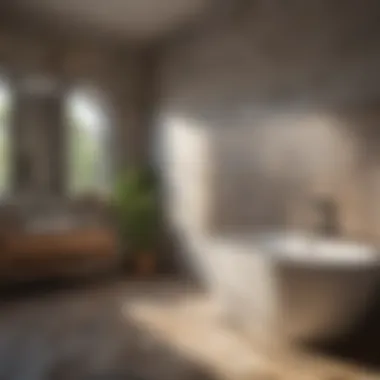

Durability and Longevity
When it comes to durability, tiles are often touted as the gold standard, but don’t count panels out just yet. While it’s true that ceramic tiles can last decades when installed and maintained properly, some panels are catching up in this regard.
Materials like high-density PVC or reinforced acrylic demonstrate impressive resilience against moisture and day-to-day wear. Of course, certain wooden panels may have limits, especially in humidity-heavy spaces, but today's treatments help extend their life.
Longevity also hinges on how well materials are installed; poorly installed tiles can peel or crack just as easily as low-quality panels. Thus, it is critical to focus not only on the material but so much on the craftsmanship that goes into installing your bathroom renovation.
"In the ever-evolving world of bathroom design, making an informed choice can be a game changer."
Navigating through these comparisons allows homeowners to make well-rounded choices that harmonize with their design ambitions, while also considering practicality in function and budget. Each option offers advantages, but understanding the core distinctions could save time, money, and a fair share of headaches down the line.
Types of Bathroom Panels
When considering alternatives to traditional bathroom tiles, understanding different types of bathroom panels is crucial. Each material comes with its own benefits, drawbacks, and aesthetic possibilities. These panels not only enhance the room's look but also address practical concerns like maintenance, durability, and moisture resistance. Let's break down some common types of bathroom panels that can elevate your bathing space.
PVC Panels
PVC panels are popular thanks to their cost-effectiveness and versatility. Made of polyvinyl chloride, these panels are lightweight and resist moisture exceptionally well. This makes them ideal for bathrooms where humidity can be an issue. Furthermore, installation is a breeze, often requiring just adhesive and a few basic tools.
In terms of design, PVC panels come in numerous colors and patterns. They can easily mimic the look of tiles or even wood without the expensive upkeep. One thing to keep in mind, however, is that while they can look refined, they're often seen as less luxurious compared to more premium materials.
Acrylic Panels
Acrylic panels stand out with their sleek appearance and high-gloss finish. They are highly resistant to stains, which makes cleaning a very simple task. Homeowners love the fact that marks can be wiped clean without any special products. An added benefit is the insulation properties of acrylic, helping to keep water warm during those chilly winter mornings.
With acrylic, you can get creative too. They come in various colors and even transparent options, which work well with backlighting to create a stunning visual effect. Keep in mind, though, that they can be scratched more easily than other materials, so caution is needed during installation and cleaning.
Wooden Panels
Wooden panels offer a warm, natural aesthetic that can transform any bathroom into a serene getaway. These panels often convey luxury and depth, and they can contrast nicely with white fixtures or modern decor. However, it's essential to use treated wood or waterproofed options to prevent warping and decay. Without proper treatment, wooden panels might buckle or decompose over time, particularly in high-moisture environments.
In addition to their beauty, wooden panels tend to be a sustainable choice if sourced responsibly. Opting for forested products with certifications ensures a greener option, aligning with eco-friendly household decisions.
Glass Panels
Glass panels evoke a sense of openness and sophistication. They can be used in the form of shower enclosures or large accent walls, offering both aesthetics and practicality. One of the most significant advantages of glass is its ease of cleaning; a quick wipe-down after each use practically eliminates soap scum and water spots, keeping your bathroom looking fresh.
Though beautiful, glass panels can come with price tags that might make some think twice. Additionally, they require careful handling during installation, needing a secure fitting to avoid accidents. Overall, whether you opt for frosted glass for privacy or clear glass for a more open feeling, this material can elevate the ambiance of your space dramatically.
"The right choice of bathroom panels can make or break the look and feel of a space, ensuring it remains as functional as it is beautiful."
In summary, exploring the various types of bathroom panels gives homeowners options that suit both personal taste and practical needs. Each material has its unique features and considerations, making it essential to weigh the pros and cons before making a decision.
Installation of Bathroom Panels
Installing bathroom panels can fundamentally change not just the functionality of your space but also elevate its aesthetic vibe. The process involves several key components that anyone looking to upgrade their bathroom should grasp. This section provides a clear roadmap to understanding how to install these panels effectively, which can save you time, money, and a few headaches along the way.
Preparation of the Surface
Before you even think about slapping those panels up on the wall, it’s crucial to prep your surface. This step can't be underscored enough. Your choices in materials and the investment you've made can go to waste if you don't lay a solid foundation. Any existing tiles, mold, or uneven patches must be addressed first.
- Cleaning Up: Removing old tiles may involve some elbow grease. A chisel and hammer might be needed if tiles are stubborn. Make sure to clean the surface to prevent dust and debris from interfering with adhesion.
- Smoothing Out: Check for bumps or holes. Rectifying any imperfections with a leveling compound ensures a flat surface for your panels.
- Drying Time: Allow everything to dry if you're using any compounds. Caught in a hurry, you may face issues further down the line.
Tools Required for Installation
Having the right tools at your disposal can make installation cumbersome rather than straightforward. Here’s a list of essentials that you will want to have handy:
- Measuring Tape: Efficient for accurate measurements to cut down on errors.
- Utility Knife: Used for cutting panels easily.
- Adhesive: A high-quality adhesive suitable for bathroom use will keep the panels in place.
- Level: Ensures your panels sit straight, preventing a wonky look.
- Caulk Gun: If you’re sealing edges, this is a must.
- Safety Goggles: Better safe than sorry, as a precautionary measure.
Step-by-Step Installation Process
Now, onto the meat and potatoes of panel installation. Following a methodical process can keep things organized:
- Measure and Mark: Start by measuring the wall(s) thoroughly. Use a pencil to mark where panels will go.
- Cut Panels to Size: Depending on your measurements, cut the panels with a utility knife. A straight edge can help get those lines perfect.
- Apply Adhesive: Spread the adhesive on the back of the panel evenly. Don’t skimp here; it’s the glue that holds the whole project together.
- Affix to Wall: Firmly press the panel against the wall, using a level to make sure everything is even.
- Repeat Steps: Continue applying panels as needed. Take frequent breaks to check everything is still aligned.
- Finish Off with Caulk: Use a caulk gun to seal edges and any gaps for a smooth finish.
Professional vs. DIY Installation
This brings us to a crucial decision: to tackle it yourself or hire professional help. Each route has its merits, and depending on your comfort level with tools and the project specifics, you might sway either way:
- DIY Installation: This is generally more cost-effective, allowing you to keep the budget in check. It can be a rewarding experience, transforming your space with your own two hands. However, time and patience are vital attributes to succeed. Mistakes may lead to additional costs down the road.
- Professional Services: While this comes with a price tag, expertise can ensure a seamless installation. If you’re unsure about your skills or are facing an intricate design, it could be worth the investment to hire a skilled contractor.
In the end, installation is a pivotal part of the journey to a new bathroom aesthetic. With diligent prep work, good tools, a defined process, and a decision on your installation route, your bathroom panels will not only look good but also serve you well for years to come.
Benefits of Choosing Panels
Choosing bathroom panels over traditional tiles can be a game-changer, especially when you consider the myriad benefits that come with them. Homeowners and enthusiasts alike are increasingly moving toward panels for a more practical, stylish, and cost-effective solution. This section outlines the specific benefits of bathroom panels and why they might deserve a spot in your renovation plans.
Water Resistance
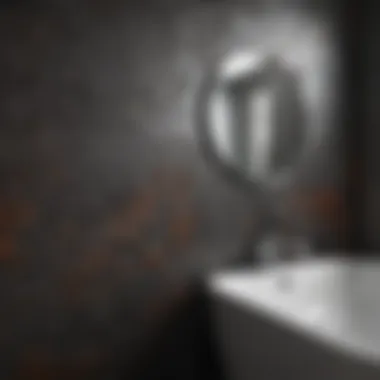

One of the standout features of bathroom panels is their remarkable water resistance. Unlike tiles, which can sometimes fall prey to cracks or grout deteriorating under the relentless attack of moisture, panels are designed to withstand damp environments. They act as a formidable barrier against water ingress, protecting the underlying structures from potential harm.
For instance, when you fit PVC panels in a wet area, they repel water, preventing mold and mildew from making themselves at home. This quality is particularly valuable in showers or around bathtubs, where the chance of splashing is high. This means less time spent worrying about hidden leaks, and more time enjoying your bathing sanctuary.
Thermal Insulation
Bathroom panels can also provide notably better thermal insulation compared to traditional tiles. In the colder months, stepping onto ice-cold tiles can feel like a rude awakening. However, panels, especially those made of quality materials like acrylic, offer a level of insulation that keeps your space warmer.
This not only enhances comfort but can also contribute to lower energy bills. A warmer bathroom means your heating system doesn’t have to work as hard, allowing for better efficiency. In essence, bathroom panels help create a cozy environment to relax in after a long day, something everyone can appreciate.
Eco-Friendly Options
In a world that’s becoming increasingly environmentally conscious, the opportunity to incorporate eco-friendly options is paramount. Many bathroom panels are now made from sustainable materials. For instance, bamboo panels are gaining traction for their rapid renewability and minimal ecological footprint, presenting a perfect chance to upgrade while keeping eco-ethics in mind.
Additionally, several manufacturers are prioritizing recyclable materials in their production processes, showcasing a commitment to reducing waste. Opting for eco-friendly panels allows homeowners to contribute to a healthier planet while enhancing their living space. It’s a win-win scenario that aligns beautifully with modern values.
Design Flexibility
When it comes to aesthetics, bathroom panels offer unparalleled design flexibility. Unlike tiles that often come in limited shades and patterns, panels can be found in a dazzling array of colors, finishes, and textures. You can mix and match styles to create a unique look that reflects your personal taste.
Whether you prefer the sleek, modern appeal of glass panels or the rustic charm of wood-like finishes, the options are nearly limitless. Additionally, panels can easily adapt to any existing decor, making it simple to refresh your bathroom without overhauling the entire space. With slides and patterns at your disposal, you can express creativity and individuality like never before.
"Bathroom panels aren't just a practical addition; they're a canvas for your creativity!"
In summary, the advantages of choosing bathroom panels are compelling and offer multiple benefits that contribute to a better overall experience in your bathing area. With their water resistance, thermal insulation, eco-friendly options, and design flexibility, panels stand out as more than just an alternative to tiles—they represent a forward-thinking choice for modern homes.
Potential Drawbacks of Bathroom Panels
While bathroom panels are gaining traction as a stylish and practical alternative to tiles, it's equally important to address their potential drawbacks. An informed decision requires weighing the benefits against these considerations. Homeowners might find smoother installations and lower maintenance appealing, but some challenges lurk beneath this surface appeal. This section dives into key concerns regarding bathroom panels, specifically focusing on material longevity, costs, and installation hurdles.
Limited Longevity for Certain Materials
When it comes to durability, not all bathroom panels stack up equally. For example, while PVC panels can be quite durable, their lifespan is often subject to environmental variables like humidity and temperature fluctuations. In less-than-ideal conditions, panels made from certain materials might yellow or warp over time. Homeowners considering these options must therefore think about the long-term implications.
"Longevity might be the last thing on one’s mind when redecorating, but it’s certainly a critical factor in avoiding future headaches."
Materials such as wooden panels, while visually appealing, may not be the best choice in areas of heavy moisture exposure. Even with effective sealants, the risk of mold and rot can pose significant problems after a few years. Therefore, homeowners should do their homework, carefully selecting panels that suit both their aesthetic desires and environmental needs.
Initial Costs of Quality Panels
Quality often comes at a price, and bathroom panels are no exception. Investing in high-quality materials can mean higher upfront costs, especially when opting for sustainable, eco-friendly materials or designs that stand out. For instance, luxurious glass or expertly crafted acrylic panels can demand a considerable investment.
Despite the premium price tag, it’s crucial to consider the potential return on investment. While an initial splurge can make you wince at check-out, durable panels often pay off in terms of longevity and minimal maintenance costs in the long run. Thus, a comprehensive cost-benefit analysis can help homeowners weigh these considerations thoughtfully.
Installation Challenges
Tackling installation can be another bump in the road. While many assume that panels are easier to install than traditional tiles, this is sometimes an oversimplification. Even with panels, a lack of proper preparation can lead to significant setbacks. The surface beneath, whether it’s drywall or an existing tiles, needs to be painstakingly prepared to avoid future problems.
Mistakes during installation can end in costly repercussions. If not secured correctly, panels may sag or become loose over time, leading to potential water damage. It might be tempting for DIY enthusiasts to take this on themselves, but tempering enthusiasm with caution is wise. Consulting professionals might be a safer bet for those who are uncertain about their installation capabilities.
Design Ideas with Bathroom Panels
Designing a bathroom is often seen as a chance to reflect personal style while ensuring functionality. With the rise of bathroom panels as a stylish alternative to traditional tiles, homeowners have an array of options to play around with. These panels lend themselves to design ideas that can elevate the aesthetic appeal of a bathroom.
Color Schemes and Patterns
When thinking about color schemes, panels offer a vast playground. Unlike tiles, which often come in typical neutrals or patterns, bathroom panels can shine with bolder hues or unique prints. One can choose a solid color for a minimalist vibe or a vibrant mosaic pattern to catch the eye.
For instance, a soft blue or green can evoke a spa-like atmosphere, while deeper shades such as navy or charcoal create a cozy, intimate feel. Some panels even come with elegant finishes like gloss or matte which can enhance the overall design.
Combining different colors and patterns, such as using a solid base with patterned feature walls, allows for creativity. This flexibility lets one define their personal style without the limitations that tiles might impose.
Incorporating Lighting
Lighting in bathrooms can make or break the overall ambiance. Using panels strategically can enhance lighting effects. Panels with reflective surfaces or lighter colors create an illusion of brightness, efficiently bouncing light around the room.
Consider adding ambient, task, and accent lighting. Under-cabinet lights can highlight the beauty of paneling, while backlit panels can create a warm, inviting glow. Also, installing recessed lighting in association with the vertical space used by panels can add depth, emphasizing their texture.
Incorporating lighting around mirrors framed by panels can also draw attention and enhance functionality without overwhelming the space. Thus, light becomes an ally in showcasing the vivid design options of bathroom panels.
Textural Elements to Enhance Aesthetics
Texture plays a fundamental role in elevating design. Bathroom panels can come in various textures such as wood-grain finishes, smooth acrylics, or glossy tiles. Incorporating a mix of textures can lead to a visually interesting affect that keeps the eye engaged.
For instance, pairing sleek glass panels with wooden accent features achieves a harmony between the contemporary and the traditional. Alternately, one could opt for embossed panels that create a three-dimensional effect, adding depth and tactile interest to the environment.
Furthermore, layering different tones or textures within panels can add luxury without breaking the bank. Such choices not only increase the aesthetic appeal but also reflect a level of sophistication and attention to detail that stands out.
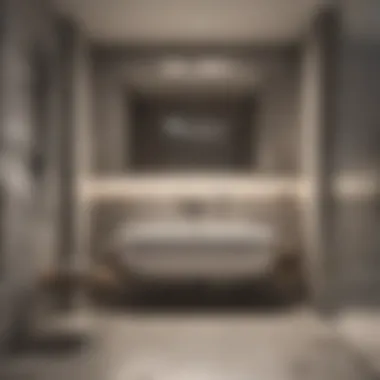

"When designing with bathroom panels, remember that every decision counts; colors, lights, and textures weave together to create your oasis."
In summary, design ideas with bathroom panels extend beyond mere aesthetics. They encompass the colors that speak to you, the lights that create ambiance, and textures that invite touch. Harnessing these elements can transform a standard bathroom into a personal sanctuary.
Case Studies and Real-Life Applications
Case studies offer real-world examples that bring theory into perspective. They provide insights into how bathroom panels are being utilized in various settings, demonstrating both the practicality and aesthetic benefits of this alternative to tiles. By examining real-life applications, readers can glean valuable information about design choices, materials used, and installation processes. This section reveals how homeowners and businesses alike have embraced panels, shining a light on the transformative potential the right choice can have on a space.
Residential Projects
In residential settings, bathroom panels have become a go-to option for many homeowners looking to spruce up their spaces without the fuss of traditional tiles. One such example is the renovation of a modest suburban bathroom where the homeowner opted for PVC panels. This choice was driven by not only the budget, but the ease of installation and maintenance.
The panels were installed directly over existing tiles, eliminating the need for messy demolition. With vibrant colors and wood-look finishes, the space transformed, turning an outdated area into a modern sanctuary. The homeowner reported that cleaning became a breeze, and the moisture resistance offered peace of mind after long showers. It was a win-win move that resulted in increased home value and a pleasing aesthetic.
Another case involved a family who opted for acrylic panels in their master bath. This family started their project with the intention of modernizing their aged decor. Acrylic’s sleek finish and variety of colors allowed them to select a design that complemented their contemporary home style. Installation was straightforward—no grout lines to worry about—and the easy-to-clean surface made maintenance a non-issue, even with children in the house.
Commercial Spaces
The versatility of bathroom panels extends beyond homes; they’re increasingly popular in commercial settings, too. A notable example can be seen in a boutique hotel that focused on providing a uniquely luxurious experience for its guests. The hotel's management chose glass panels to create a high-end look in their bathrooms.
"The use of glass panels not only elevated the design but also added an element of spaciousness," mentioned the interior designer in charge of the project. Glass reflections make rooms feel larger, a trick particularly beneficial in smaller bathroom spaces.
Moreover, the hotel managers appreciate the visual aesthetic and the ease of maintaining glass. Special coatings prevent water spots and make cleaning day-to-day a simple task. The glass panels significantly reduced maintenance time, allowing staff to tend to other areas of the establishment.
Additionally, a gym facility incorporated wooden panels in their locker rooms, creating a warm ambiance that makes patrons feel more relaxed. The choice of materials played a significant role in branding the gym—promoting a natural and healthy lifestyle. The rich texture and user-friendly attributes made for a well-received design change by both staff and gym-goers alike.
In summary, case studies from both residential and commercial projects highlight how bathroom panels, in various materials and designs, not only meet aesthetic needs but also address functional requirements. Homeowners and business operators gain practical insights, encouraging them to consider panels as a viable alternative to tiles, thus reflecting a broader trend toward modern bathroom solutions.
Future Trends in Bathroom Panel Design
As we look ahead, the bathroom design landscape is evolving, influenced by changing consumer preferences and technological advancements. Understanding the future trends in bathroom panel design is vital for anyone renovating or building a bathroom. It directly connects to considerations of sustainability, functionality, and creativity, which resonate with homeowners looking for both style and practicality. This section uncovers exciting elements set to transform bathroom spaces in the coming years.
Sustainable Materials
Sustainability becomes more than just a buzzword; it’s a necessity. Homeowners are increasingly prioritizing materials that minimize environmental impact. Sustainable bathroom panels may incorporate recycled products or sustainably sourced raw materials. For instance, panels made from bamboo or recycled plastic not only provide aesthetic appeal but also reduce your carbon footprint. By selecting eco-friendly options, you're showing that contemporary bathroom design can be stylish without sacrificing planet health.
Benefits include:
- Less Waste: Sustainable materials help in reducing landfill waste.
- Energy Efficiency: Many sustainable options also contribute to energy-efficient homes, enhancing thermal performance.
- Healthier Environment: Low-VOC materials improve indoor air quality.
As the trend for eco-friendly living takes root, expect to see a wider array of sustainable material choices in the market.
Smart Technology Integration
With the advent of smart homes, integrating technology into bathroom design is no longer a novelty but an expectation. Smart bathroom panels are on the rise, offering features such as touch-sensitive controls, integrated lighting, and even temperature regulation. Imagine panels that can automatically adjust to humidity levels or change colors based on your mood – that’s the future!
The advantages of smart panels include:
- Enhanced Convenience: Easily adjustable settings suitable for personal needs.
- Increased Safety: Sensors alert users to moisture build-up, preventing mold.
- Energy Savings: Smart technology can help minimize energy use through real-time adjustments.
The incorporation of smart tech is paving a fresh path in bathroom design, blending modern convenience with elegant aesthetics.
Customization Options
Personalization is the name of the game in contemporary interior design. Bathroom panels are increasingly becoming customizable, allowing homeowners to tailor their spaces to reflect their unique tastes. Options might include diverse patterns, colors, textures, and sizes that cater to individual preferences.
Buyers can choose from an array of geometric prints, soft pastels, or even nature-inspired designs that evoke a sense of tranquility. Customization can turn an ordinary bathroom into a personalized sanctuary, representing individual style and enhancing overall comfort.
Key benefits of customization include:
- Unique Aesthetic: With endless design opportunities, homeowners can create visually striking spaces.
- Better Functionality: Tailoring panels to fit peculiar space dimensions or features.
- Increased Property Value: Customized upgrades can boost a home's market value.
In summary, the future of bathroom panel design is bright, marrying sustainability, technological innovation, and personalized aesthetics. Embracing these trends offers a chance to not just keep up with design advancements but to build spaces that resonate with personal style and modern needs.
The End
In the grand scheme of home improvement, the choice between bathroom panels and traditional tiles is not just a matter of looks, but also functionality and practicality. As we've explored throughout this article, bathroom panels provide a modern alternative that caters to the evolving needs of homeowners. They enhance the aesthetic appeal of a space while promising ease of maintenance, cost savings, and versatility in design.
Understanding the specifics that both options bring to the table is crucial for making informed decisions. Bathroom panels, with their array of materials like PVC, acrylic, wood, or glass, offer unique benefits tailored to different preferences and budgets. In today’s fast-paced world, it’s essential to find solutions that are not just stylish but also practical.
Having laid out the pros and cons, it's clear how panels hold their own against conventional tiles. They can adapt to various styles—from luxurious to minimalistic—while allowing for a personalized touch to any bathroom environment.
"Choosing the right material is often a balancing act between beauty and practicality."
As we now distill the main takeaways from our discussion, here’s what stands out as key points in favor of bathroom panels:
Summary of Key Points
- Cost Efficiency: Installation and long-term maintenance of panels can be lighter on the wallet compared to traditional tiles.
- Ease of Installation: With many panels designed for simple installation, even DIY enthusiasts can manage the task.
- Water Resistance: Panels, crafted from materials with enhanced water protection, reduce the risk of mold and mildew.
- Aesthetic Variety: The vast range of panels offers flexibility for homeowners to design their dream bathroom without being limited by conventional tile options.
Final Thoughts on Choosing Panels
When contemplating a bathroom renovation, the decision to choose panels over tiles should align with both your personal style and functional requirements. Consider your lifestyle, budget, and ultimately the aesthetic you desire to achieve. Although tiles have been the traditional favorite, bathroom panels present a compelling alternative, with clear advantages in maintenance and innovation.
As you embark on this journey for a new bathing space, weigh your choices carefully and explore the potential that panels offer. The world of bathroom design is continually changing, and embracing these advancements could lead to a refreshing transformation in your home.













